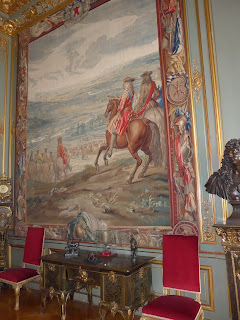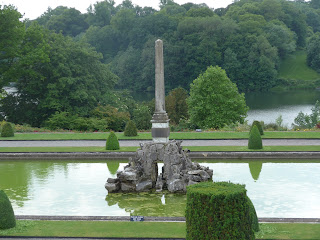The Brook at one time powered a flour mill, the first mention of which dates back to the 1086 Domesday Book.
 |
| The Mill is now a museum and pricey gift shop |
The Brook is a pretty tame waterway, but the parents of these cygnets were nowhere to be seen. A local woman I met along the path told me that there had originally been nine of these baby swans, and she expressed serious concern that these last two would also come to a bad end unless their parents re-appeared.
These lambs relaxing in the adjacent fields don't seem concerned.
Nor this most attractive moth ...
 |
| Or is it a butterfly? Perhaps some lepidopterist can settle the question .... |
... eventually leading to Upper Slaughter and the manicured lawns of the swanky Lord of the Manor Hotel, where Louise was waiting for me.
 |
| Croquet, anyone? |
 |
| They clearly weren't hiking through the countryside .... |
Somehow in this tiny town, Louise and I got separated, so once again, I'm traveling the path back to Lower Slaughter without her, although there are plenty of other people and their pets.
We swung through another highly-touted Cotswolds town, Bourton-on-the-Water, but it was crowded, commercial, not terribly charming. and overrun with tourists, chain stores and tee shirt shops.
 |
| Over-rated Cotswolds town .... |
 |
| We could see these ducks anywhere ... |
 |
| This mill was once the largest employer in the area; it's now a fancy condominium. |
 |
| John Churchill was the General whose wife's close friendship with the Queen lasted just long enough to get most of the money to build the Palace. |
Given the connection with Louis XIV, I'm sure it's not coincidental that Blenheim's layout is reminiscent of Versailles.
The Palace is replete with Marlborough martial memorabilia, both actual

and miniature.
The dining room is not exactly intimate ...
... and you certainly would need to know which fork to use!
And speaking of silver, this enormous centerpiece was referred to as her cache mari by the 9th Duchess, Consuelo Vanderbilt, because the piece was so large that she could have it placed on the table to completely hide the view of her detested husband, the 9th Duke.
 |
| That's the First Duke on horseback. The photo does not do justice to the size and scale of this piece, which weighs several hundred pounds. |
 |
| She divorced the Duke and re-married happily.
The grounds are equally impressive.
Various of the Dukes and their kin are entombed in this elaborate mausoleum.
|
Blenheim Palace of course, would be only one of many "stately piles" available for viewing around the UK, except that this particular pile has the most intimate connection to the most important Englishman of the last several centuries.
 |
| Churchill's Hussars uniform |
 |
| More of his cavalry rig |
 |
| WSC's velvet slippers |
 |
| And one of his velvet "siren suits" that Churchill wore during WWII, made for him by my own tailors, Messrs. Henry Poole, Savile Row .... |
Blenheim was where he proposed marriage to Clementine Hozier (whose own provenance is a matter of speculation and controversy, since her mother was notorious for her infidelities. Clementine is reputed -- even by her own daughter -- to have been sired by one of at least two men other than her putative father.)
 |
| The proposal site: the Temple of Diana |

There are no signs or obvious directions to this humble graveyard. No eternal flames or other garish monuments.
 |
| This is it. Churchill's grave. A heart at peace, under an English heaven. |
 |
| And his mother. |
 |
| And here is Consuelo Vanderbilt, identifying herself only as the mother of the 10th Duke. |







































No comments:
Post a Comment